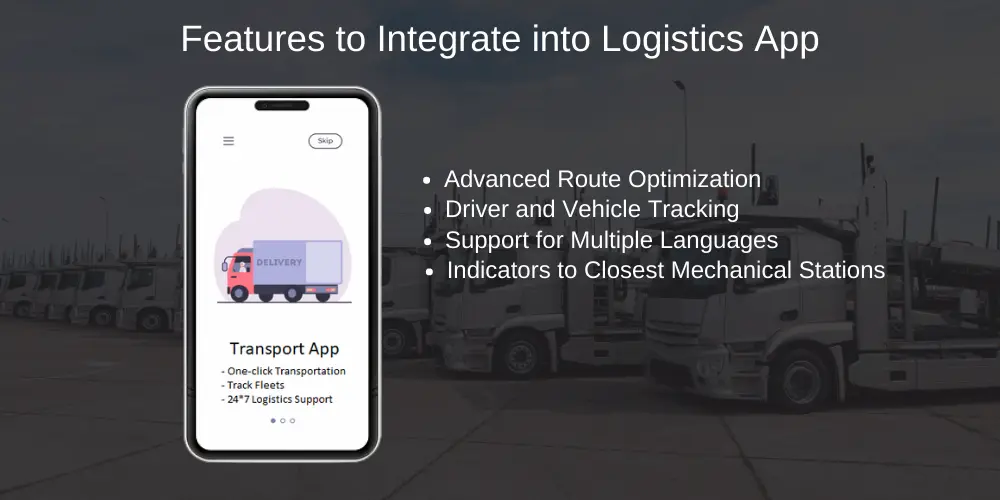In the past decade, the massive growth of the eCommerce sector has compelled logistics companies to adapt and improve their operations. And there is no better way to improve than introducing a neatly packaged mobile application containing all the essential features. All the features in your app should aim to increase the productivity of managers and drivers to maximize the company’s resources. Here are four key features to consider when you develop a custom mobile application for your logistics business.
Table of Contents
Four Must-have Features for Your Logistics Mobile Application
You can not miss out on the following features while building your logistics mobile app.
1. Driver and Vehicle Trackers
Driver and vehicle tracking are the supporting pillars of any modern logistics mobile app. Companies can track their fleet and make more informed decisions. Fleet managers can also track their drivers’ performances.
The logistic companies can track whether their drivers are on schedule or if they are running late. These trackers also alert the managers whenever a driver arrives at the warehouse, allowing them to streamline delivery assignments. The driver’s details are stored on the cloud and can be easily accessed by the internal team.
Primarily, the vehicle trackers are based on GPS technology. But some are generated using the Global Navigation Satellite System (GLONASS). The vehicle trackers track the total mileage, engine status, and fuel consumption.
This way, it becomes easier for the business to calculate its expenses. If the driver uses the vehicle for personal reasons during the off-hours, the app should be optimized to track the distances covered only for business purposes. All this information is stored in the cloud and can be accessed while creating expense reports.
2. Advanced Route Optimization
The mobile logistics app should also have a prior route planning feature. Of course, your regular navigation apps, like Google and Apple maps, already have the route optimization feature. However, it involves opening another app and typing the destination manually.
With an advanced integrated map and route optimization software, the drivers can easily access the directions for delivery without needing to juggle between different apps. The fleet managers also create specific routes for multiple vehicles through the logistics mobile app, which is impossible with other navigation apps.
There are numerous other benefits of having route planning optimization. To begin with, the company can find the most cost-effective route for their deliveries. As a result, the fuel expenses decrease along with the overall maintenance cost of the vehicle. In addition, it can increase the number of pick-ups and deliveries the driver can do in a day.
This also increases the drivers’ productivity and the likelihood of getting performance incentives. The fleet managers can get optimized routes for their active vehicles with just a click of a button; hence they do not have to spend hours manually creating the routes. As you can see, route optimization with advanced machine learning algorithms is one of the must-have features for logistics mobile apps.
3. Closest Mechanical Support Stations Indicators
Sometimes drivers may face unwarranted vehicle issues, which might upset their schedule and affect overall travel time. Therefore, logistics businesses need to consider the assistance they can arrange for their drivers during such situations.
The GPS navigation system allows fleet managers to search for the closest repair stations and help their drivers reach the place. If the vehicle has become undrivable, they should have a towing option within the app’s interface that can notify the closest towing company to come and help them out.
The logistics mobile app can also highlight the nearest gas stations for the drivers having trouble with their fuel systems. Combining the advanced route optimization technology with the various vehicle trackers, the app can highlight when the drivers need to stop for fuel to maximize their productivity and reduce delivery times.
The app should also show all fuel stations on the delivery or pick-up route. With such unique systems, the management can ensure that their fleet operates smoothly without any hurdles.
4. Support for Multiple Languages
This non-technical feature is also as important as some of the more technical features mentioned above. In-app support for multiple languages makes operating the app easier for drivers from diverse backgrounds.
By doing so, the company is making it easier for them to navigate various features and functions without any trouble. The app should also be able to translate the instructions of the fleet manager into the native languages of the drivers. With this feature, you can remove the communication gap and reduce productivity losses due to misunderstandings.
The logistic app should also have multilingual support for the user-facing side of the app. It instantly adds value to your product by increasing its reach. Multilingual support also increases growth opportunities for such logistics mobile apps.
The support also enables the data analyst teams to identify customer behaviour and segment them accordingly. While developing the app, some companies might think translating the app copy wastes resources. However, it is a one-time investment and drastically increases the app’s reachability, accessibility, and market value.
Conclusion
These are some key features any logistic mobile app should have to get a competitive edge in the industry. You can notice a logistic app is a mix of advanced technical features and simple non-technical solutions. Therefore, it can be difficult for some companies to navigate the intricacies while developing the app. To tackle this problem, you can always hire expert mobile development companies to build one for you.

